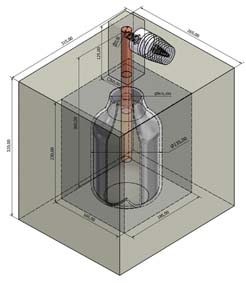
Cavanilles Institute researchers of the University of Valencia have created the first microbial thermoelectric pile (Microbial Cell Thermoelectric or MTC), a device capable of transforming the metabolic heat given off by the microorganisms in an electric current.This development, which has just been published in the journal PLOSONE, is part of the bioenergy research conducted in this institute of the Science Park by the Biotechnology and Synthetic Biology group led by Manuel Porcar .The system has applications in the biotechnology sector.
This idea stems from a question: microbial cultures heat could be transformed into electricity?To answer this the team has developed a system based on the Seebeck effect or thermoelectric effect, which states that a plate composed of two different metals in each face, when subjected to a temperature difference generates a potential difference.The system MTC uses for this purpose the form of a device which thermally connects (with a bar of cooking) a yeast culture to a termogenerator plate{ /0} whose cold side is connected to a heat dissipating radiator.Thus, the heat generated while growing yeast creates a thermal gradient in the plate which results in the generation of an electric current.
Although so far and with small volumes of culture has not gone from a few volts, researchers at the University of Valencia are working on improving system performance with microbial cultures strongly exothermic and tuning ad hoc systems for production electricity from both liquid and half solid means.-Electricity production from microorganisms is a well known phenomenon, but it was done so far by the so-called Microbial Fuel Cell, in which there is a transfer of electrons from organic matter to an anode.The MTC, however, is based on a completely different effect, the thermoelectric effect we have discussed, so that is a milestone and a first step towards the energy use of the heat given off by the microorganisms.
Applications of the system, we must mention the electricity production in biotechnology companies in alcoholic fermentations or bioremediation and composting.Finally, it is necessary to emphasize the ability of the new system to - in addition to producing electricity- regulates the temperature of crops keeping them in a suitable thermal range, so as to get at once, electricity production and saving energy in the form of refrigeration.
On publication, your paper will be available online at
http://www.plosone.org/article/info 2F10.1371%%% 3Adoi 2Fjournal.pone.0056358
Reference: Raul Rodriguez-Barreiro, Christian Abendroth, Cristina Vilanova, Andrés Moya and Manuel Porcar."Towards a Thermoelectric Microbial Cell".PLoS ONE, in press.
Last update: 27 de february de 2013 10:11.
News release



















